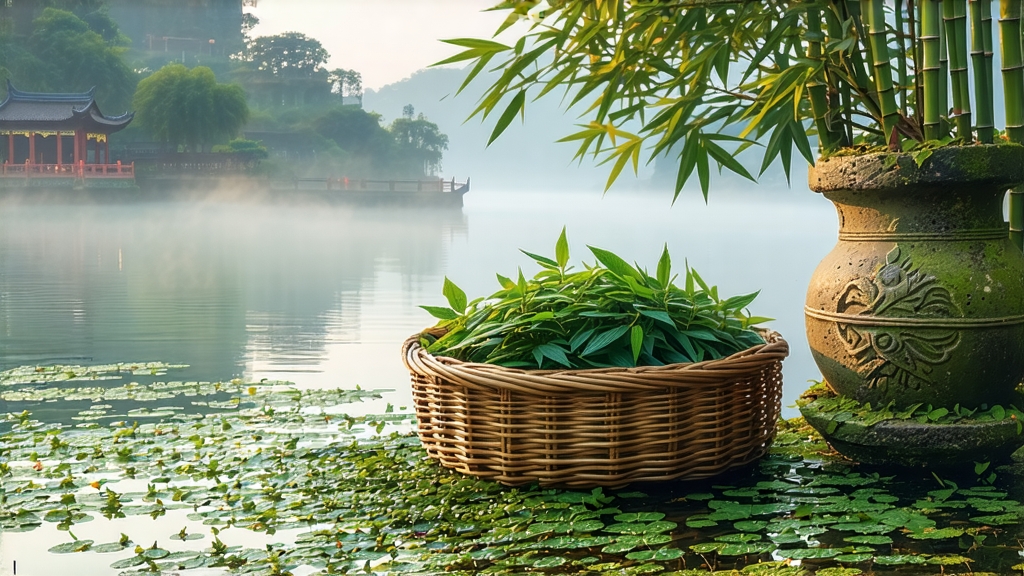
Longjing—often spelled Lung Ching in older texts—means “Dragon-Well,” a name that conjures both imperial myth and the precise geography of a single hillside in eastern China. To most Chinese, the word itself is shorthand for the nation’s most celebrated green tea, the benchmark against which all other greens are silently judged. Yet outside China, Longjing is still mistaken for a generic style, a pale, flat leaf that simply looks elegant in a glass. This article invites the global tea lover to step past the souvenir tin and meet the living culture inside: a 1,500-year story, a craft that depends on the exact temperature of a carbon-steel wok, and a flavor that can whisper freshly cut grass, roasted chestnut, and the limestone minerality of West Lake all in one sip.
History: From Temple to Palace to Proletariat
Buddhist monks at Longjing village began cultivating tea during the Eastern Jin dynasty (265–420 CE), initially as a meditation aid. By the Tang era, the same spring that fed their temple—an auspicious well shaped like a crouching dragon—gave the tea its name. Song-dynasty poets compared the infusion to “liquid jade,” but the real apotheosis arrived in 1751 when the Qianlong Emperor, touring the south, planted eighteen bushes himself and decreed the leaves an imperial tribute. Legend claims he was so enamored that he pocketed fresh shoots in his sleeve, forgetting court etiquette; when the leaves released their aroma, he instantly elevated Longjing to gong cha—“palace tea.” After the fall of the Qing, the Republican era saw the gardens privatized; by the 1980s, household责任制 allowed individual farmers to keep their own micro-plots, and the modern auction market was born. Today, a single kilo of pre-Qingming (Mingqian) West Lake Longjing can fetch over 10,000 RMB, yet every spring, Hangzhou locals still queue at dawn for 50 g packets, proof that this tea belongs as much to street-corner grandfathers as to oligarchs.
Terroir: Why West Lake Matters
China now grows “Longjing-style” tea in Yunnan, Sichuan, even Guizhou, but connoisseurship begins with the original microclimate: a narrow crescent of hills northwest of Hangzhou where the subtropical sun is filtered through humid lake mist. The water itself—West Lake—moderates temperature swings, while the surrounding peaks trap cloud cover like a silk scarf. Soils are quartz-rich and slightly acidic, laced with the same limestone that carved the famous caves at Feilai Feng. The result is a slow-growing leaf with unusually high theanine and low catechins, yielding sweetness without astringency. Within the core zone, further hierarchy exists: Shífeng (Lion Peak) commands the highest prices, followed by Méijiāwǔ, Wēngjiāshān, and Hǔpáo (“Tiger-Running Spring”). Each sub-village argues its own minerality: Shífeng is said to taste of wet slate, Méijiāwǔ of steamed edamame, Hǔpáo of sweet corn.
Cultivars: Beyond the Iconic Leaf
Although the classic Longjing bush is the Hangzhou Qunti (“group seed”) heirloom—open-pollinated, with serrated leaves that curl like sparrow tongues—farmers now balance tradition with resilience. The #43 clonal variety, released in 1970, buds ten days earlier, survives frost better, and offers a brighter, almost spinach-green infusion. Purists complain it lacks the lingering “orchid finish” of Qunti, yet it dominates early-spring market stalls. A third cultivar, Zhongcha 108, trades some fragrance for yield, while local experimenters graft Longjing scions onto Yunnan rootstock to fight drought. Whatever the cultivar, the leaf must still pass the “five excellences”: jade green color, flat shape, crisp snap, lasting aroma, and a pale but luminous liquor.
Craft: The 10-Minute Dance of Fire and Fingertips
Longjing is pan-fired, not steamed like Japanese sencha, and the difference is theatrical. Within hours of plucking, leaves are sieved to remove morning dew, then “quieted” in bamboo trays for two hours to reduce surface moisture. The master roaster—often a